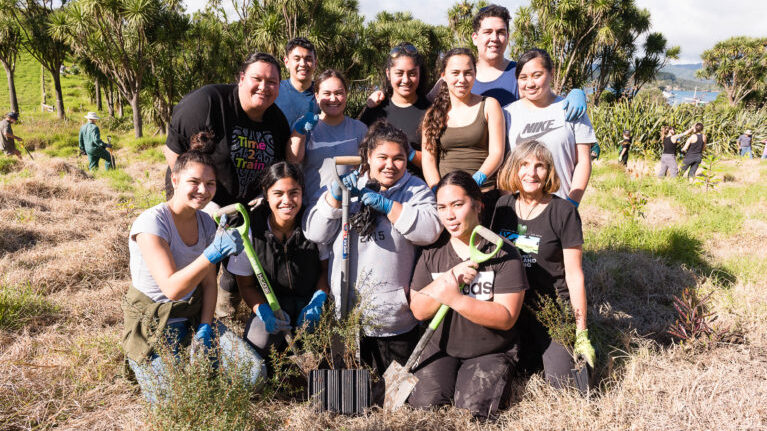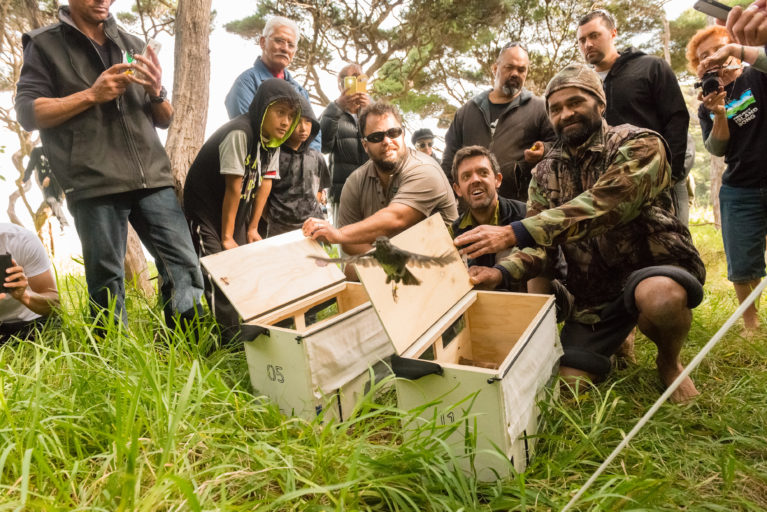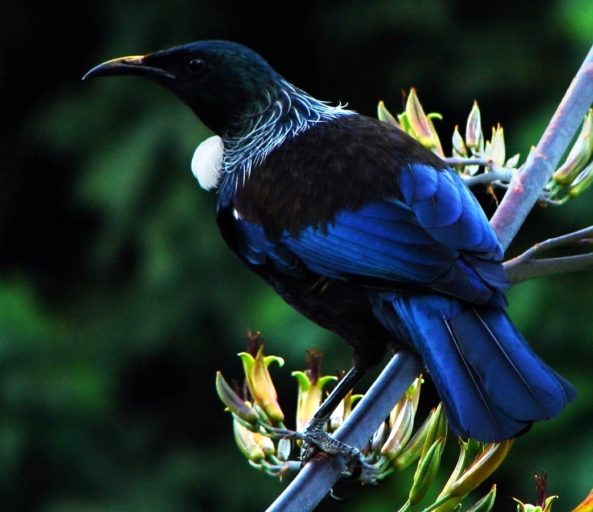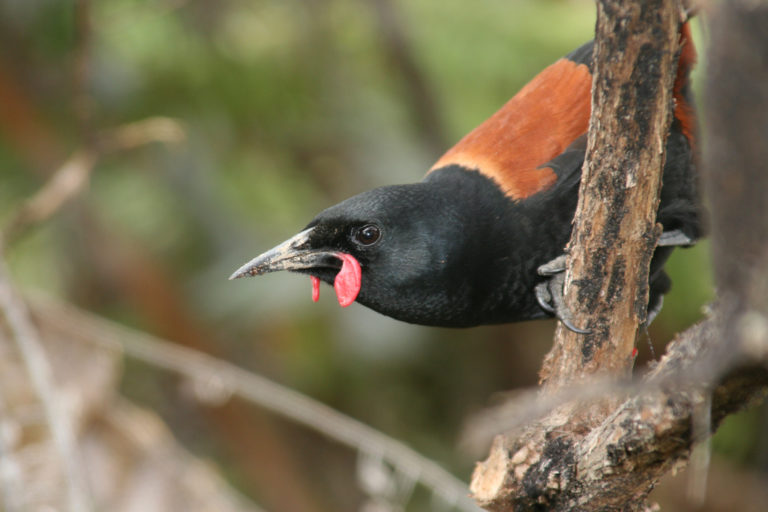When you remove predators from islands and restore forest habitat, the expectation is that native forest birds will flourish and that the new ‘improved’ conditions may favour native birds over introduced species. But is that what happens?

Researchers John Ralph, Carol Ralph and Linda Long looked at how bird populations on the seven islands and many smaller islets that make up the Ipipiri Group in the eastern Bay of Islands, northeast of Russell have responded to the extensive restoration work carried out by Project Island Song. The results of their study were recently published in Notornis, the research journal of Birds New Zealand (the New Zealand Ornithological Society).
“The reestablishment of bird species that have become locally extinct is a central theme of conservation ecology in New Zealand, especially on islands. These islands have been actual islands, or areas of habitat surrounded by a predator-proof fence. When pests are removed from an island, and native trees and shrubs are planted and regeneration occurs, it is envisaged that native ecosystems will be restored and previous niches for birds recreated. In this event, we would predict that:
- most native birds (especially forest species) would increase;
- translocated species, reintroduced onto the islands, would also increase: and
- exotic, non-native (introduced in the last 150 years) species would decrease.”
“These predictions are basic tenets of restoration ecology, with tests of these recorded on few occasions in New Zealand, by following pest control actions with monitoring, in order to assay the efficacy of the actions and to guide management.”

Islands in the Iripiri Group were grazed for over a century, following European settlement, but for the last 50 years that has been changing.
“…the past 50 years have seen a gradual change with decreased grazing and increased planting of native trees and shrubs. Grazing ended and planting began on most of the islands about 2000. Grazing continues today only in a fenced area of about one-third of Urupukapuka Island.”
In June 2009, a concentrated pest control programme was begun under the aegis of ‘Project Island Song’, a collaboration between organizations and individuals to restore the native birds and habitats.
“Thus, began one of the more ambitious conservation experiments in the country. To monitor its effects, we report here on bird counts started in November and December 2008 before the eradication and continued on for nine years through January 2017.”
Birds are a key part of the biota of the islands and the researchers categorised birdlife into three groups for their assessment of the response to intensive predator control and restoration.
“We refer to three groups of birds as:
- the ‘non-native’ species, introduced from outside of New Zealand in the past 150 years;
- the endemic ‘native’ species that have evolved in New Zealand; and
- the ‘recent immigrants,’ species that have relatively recently colonized New Zealand, and have diverged only slightly from their Australian relatives.”
Following the restoration work, several endemic native species have been reintroduced back to the Ipipiri island group.
“Between 2012 and 2016, five species have been reintroduced to various islands of Ipipiri: brown teal to Urupukapuka in September 2012; North Island robin to Moturua in 2014 (to augment 16 released in 1986, from the Mamaku Plateau) and to Urupukapuka in July 2016; whitehead to Motuarohia in May 2015 and to Urupukapuka and Moturua in April 2016; North Island saddleback to Moturua and Urupukapuka in March 2015 (from Lady Alice Island) and May 2015 (from Tiritiri Matangi Island); and since our study, red-crowned parakeet to Moturua in June 2017. North Island brown kiwi are not sampled by diurnal counts and have been introduced on Moturua and Motuarohia.”

Bird monitoring to determine longterm responses to pest eradication is a key objective for Project Island Song.
“From this monitoring, we expected to find an increase in both bird numbers and species as predation and competition from rats, mice, and stoats are suddenly absent. This study contributes to the testing of this hypothesis.”
The researchers counted birds in eight routes on five of the islands in the Ipipiri group. The islands have differing land uses, conservation status, and vegetation. While Urupukapuka Island (229 hectares) is predominantly public conservation land and Moturua Island (166 hectares) largely a scenic reserve, other islands are in private ownership or uninhabited. Vegetation types include regenerating manuka and kanuka shrubland, extensive grasslands of the introduced kikuyu and coastal Pohutukawa forest.
“In June 2009, the New Zealand Department of Conservation performed an aerial drop of the poison bait Brodifacoum by helicopter with the goal of removing pests, namely stoats, mice and three species of rats from the islands. They targeted seven islands and numerous islets, including the five islands which we subsequently monitored for changes in bird populations. In the subsequent eight years, through 2017, they conducted continuous monitoring for reinvasions, followed immediately by focused eradication programmes if a pest was detected. During the first three years after treatment, they detected and removed a total of 16 incursions of rats, mice, stoats, and cats.”
Monitoring involved more than 900 station counts conducted on five islands. The researchers describe the monitoring protocol:
“[The protocol] involved a ten-minute count, consisting of two consecutive 5-minute standardised morning counts at each station, usually about 100 m apart on eight established routes, during fine weather. Birds flying overhead were counted if they were judged to be using the habitat of the count circle of 100 m. Additional species of waterbirds were tallied but not included in most analyses unless their principal habitat was on land. Most routes consisted of 15 stations. In some years, a few stations were repeated, missed, or added.”
It was very much a cooperative effort.

“Over the nine years (2009– 2017) of continuous pest monitoring and control, the bird counts were done mostly by volunteers from the Ornithological Society of New Zealand (Birds New Zealand), Guardians of the Bay, staff from the Department of Conservation (DOC), and others, working together to inform Project Island Song and DOC. Most often, to ensure good coverage two people counted each station together with one primarily recording and the other listening and looking. Of the two people, one was usually highly experienced.”
More than 20,000 birds were counted – including 4,800 tūī – the most common bird in the study.
“Three native species (silvereye, grey warbler, and welcome swallow), and the introduced common myna and house sparrow, all tallied more than 1,000 individuals each. The native New Zealand fantail and two introduced species each had more than 500 individuals. Overall, 47 species were tallied (including 35 landbirds), many of them with multiple individuals seen, and many species observed in most years.”
Some species increased and others decreased over the 9 years of pest control as a new community equilibrium was being established. The number of species that significantly changed in abundance was much larger than would have been expected by chance alone, suggesting predator control was having a significant effect.
“During the nine years of pest control, of 122 possible island-species combinations for the most abundant 27 landbird species (those with 50 or more total birds observed), 51 (42%) significantly increased or decreased as community equilibrium was being established. By chance alone, one would have expected fewer than seven to have significantly changed (5% of 122).”
So how did those changes look, in terms of the categories of ‘non-native’, ‘native’ and ‘recently introduced’?
“Of the 14 native landbird species, eight increased significantly during the pest control period in the ‘all islands combined’ analysis. Four native species (grey warbler, shining cuckoo, sacred kingfisher), and silvereye, decreased significantly. Fantail and pukeko showed no trends. The latter six species were classified as recent immigrants.”

The eight increasing species included saddleback and whitehead which were introduced after the pest control period and, as expected, had significant increases. The other six natives which increased in numbers were tūī, tomtit, North Island robin, swamp harrier, New Zealand pipit and welcome swallow.
“Tūī was the most-frequently observed species and it increased considerably for all islands and routes combined. This increase was highly significant. During the period since pest control began, this conspicuous and aggressive bird has nearly tripled in numbers; over the 20-year period, it has increased even more.”
Tomtits were another island success story, following predator control.
“Tomtit has had remarkable and significant increases as it self-introduced into the islands. This native species had not been detected in the 1996 counts, before pest control. It was confirmed to be breeding on Moturua in December 2008. Since then, it has rapidly increased on Moturua, spreading on its own to Urupukapuka, and most recently to Motuarohia. It was even detected occasionally on small Okahu Island (in 2011 and 2012). The species initially had a population increase on Moturua and, as is typical of species recently introduced, they have since apparently stabilized at a lower level.”
‘Recent immigrants’ didn’t fare so well.
“The recent immigrant silvereye was the second most common bird detected. It declined significantly during the 9-year period and also when including the 1996 counts over the 20-year study period for all islands combined, and at all three individual islands. Pukeko showed mixed results, with a significant decrease from 1996 through the 2000s, but no significant change during the 2000s. The other decreasing native species were sacred kingfisher, shining cuckoo, and grey warbler, all declined during the pest control period, depending upon the analysis.”
Many non-native species showed a very clear decline during the predator control period.
“Of the 13 common, non-native landbird species, ten species declined on all islands combined during the pest control period, including Eurasian blackbird, chaffinch, European starling, European goldfinch, European greenfinch, dunnock, common myna, Eurasian skylark, song thrush and yellowhammer. Just two species increased – eastern rosella and house sparrow. Only brown quail remained unchanged.
So the hypothesis seems to stack up – on this occasion at least. Predator control and habitat restoration benefits many native land-bird species and favours natives over introduced birds, but it wasn’t necessarily what the researchers were expecting to happen.

“We had expected the total eradication of mammalian predators to result in an increasing trend broadly across bird species, both native and non-native, with the presumption that reduction in predation and competition would be widely felt as community equilibrium was established. Rats in particular are a significant competitor with native avian species for fruits and flowers, and both rats and mice also have an important impact in preventing forest regeneration by eating seeds and seedlings. We suggest that rat removal had the major role in the trends we report.”
“The apparent effects of the increases or decreases of bird populations over the pest control period in our study is perhaps predictable. However, with some species, the effects apparently began much before the pest control period, and in a few species was a continuation of the increase or decline since 1996, when the first count was undertaken. For instance, silvereye and tūī showed a decrease and increase respectively between 1996 and the period of pest control. A possible explanation is that before pest control a modest amount of planting was taking place, grazing had been largely removed, and some form of succession was underway, heading the islands towards a more natural state of the forests.”
It may be that removal of mammal predators benefits most birds, but that the forest restoration that accompanies predator control favours natives, which are better adapted to living in the forest habitat. It certainly brought back the tūī song in the Bay of Islands – with an almost trebling of tūī numbers.

